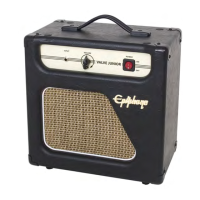
Do you have a question about the Mercury Epiphone Valve Junior and is the answer not in the manual?
| Power Output | 5 Watts |
|---|---|
| Controls | Volume |
| Tubes | 1x 12AX7 preamp, 1x EL84 power tube |
| Speaker | 8-inch |
| Inputs | 1x 1/4" instrument input |
| Type | Tube Combo Amplifier |
Critical warning regarding capacitor safety and potential discharge hazards.
Guidelines for working with solder, particularly RoHS compliant solder.
Notes on capacitor polarity and general component handling for safe installation.
Describes the amp's head/combo variants and the differences between Version 1, 2, and 3.
Details the Epiphone Valve Jr. as the chosen test amp for the upgrade.
Explains the development and testing of the Mercury transformer upgrade.
Lists the specific components required for the optional 6V6 modification.
Lists the components needed to address potential 'squeal' issues in Version 3 amps.
Emphasizes the necessity of connecting a speaker before powering up the modified amp.
Notes on PCB variations between Version 2 and 3 for the head model.
Wiring diagrams and notes for the 6V6 modification and filament connections.
Notes on PCB variations between Version 2 and 3 for the combo model.
A step-by-step outline of the entire upgrade process.
Diagram showing PCB layout with notes on version differences and component values.
Guidance on mounting resistors, differentiating between flame-proof and standard types.
Warning against bypassing the crucial power-up test procedure.
Warning against bypassing the crucial power-up test procedure for the 6V6 mod.
Explains the necessity of using a variac and current meter for safe amp power-up.
Notes for individuals who are not qualified amp technicians.
Methods for fixing damaged or missing PCB eyelets.
Techniques for scraping PCB lamination to expose copper traces.
General advice and examples for repairing PCB traces.
Explains how output transformers influence guitar tone and amplifier distortion.
Essential safety steps for discharging filter capacitors before working on the amp.
Advice for safely working inside an amp chassis, including the 'one-armed technician' method.
Details various techniques and tools for safely discharging capacitors.
Detailed methods and precautions for safely draining power capacitors.
Lists the necessary tools for performing capacitor discharge safely.
Step-by-step guide for testing residual voltage and discharging capacitors.
Concluding safety advice and reminders for working on tube amplifiers.